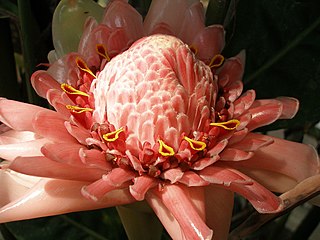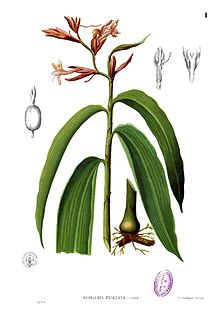
Zingiberaceae or the ginger family is a family of flowering plants made up of about 50 genera with a total of about 1600 known species of aromatic perennial herbs with creeping horizontal or tuberous rhizomes distributed throughout tropical Africa, Asia, and the Americas. Many of the family's species are important ornamental, spice, or medicinal plants. Ornamental genera include the shell gingers (Alpinia), Siam or summer tulip, Globba, ginger lily (Hedychium), Kaempferia, torch-ginger Etlingera elatior, Renealmia, and ginger (Zingiber). Spices include ginger (Zingiber), galangal or Thai ginger, melegueta pepper, myoga, korarima, turmeric (Curcuma), and cardamom.

Alpinia is a genus of flowering plants in the ginger family, Zingiberaceae. Species are native to Asia, Australia, and the Pacific Islands, where they occur in tropical and subtropical climates. Several species are cultivated as ornamental plants.

Alpinia purpurata, commonly referred to as red ginger, also called ostrich plume and pink cone ginger, are native Malaysian plants with showy flowers on long brightly colored red bracts. They look like the bloom, but the true flower is the small white flower on top.

Alpinia zerumbet, commonly known as shell ginger among other names, is a perennial species of ginger native to East Asia. The plants can grow up to 2.5 to 3 meters tall and bear colorful funnel-shaped flowers. They are grown as ornamentals and their leaves are used in cuisine and traditional medicine.

Etlingera elatior is a species of herbaceous perennial plant in the family Zingiberaceae; it is native to Thailand, Malaysia and New Guinea.

Leonotis nepetifolia,, is a species of plant in the genus Leonotis and the family Lamiaceae (mint), It is native to tropical Africa and southern India. It can also be found growing abundantly in much of Latin America, the West Indies, and the Southeastern United States. It grows to a height of 3 metres and has whorls of striking lipped flowers, that are most commonly orange, but can vary to red, white, and purple. It has drooping dark green, very soft serrated leaves that can grow up to 10 centimetres (4 in) wide. Sunbirds and ants are attracted to the flowers. It has been found growing on roadsides, rubbish heaps or waste land.

Renealmia is a plant genus in the family Zingiberaceae. Its members are native to tropical Africa and tropical America. In Peru, fruits and tubers are sources of indigenous dyes. and indigenous medical treatments for leishmania and malaria In Colombia, it is used to treat snakebite. Bracts and leaves can serve as phytotelmata, retaining small quantities of water that offer habitat for other organisms.

Desmoncus polyacanthos, the jacitara palm, is a spiny, climbing palm native to the southern Caribbean and tropical South America. Stems grow clustered together, and are 2–12 m long and 0.5–2 cm in diameter. Petioles, rachis, cirrus and peduncular bracts are covered with short, curved spines. Two varieties are recognised: D. polyacanthos var. polyacanthos and D. polyacanthos var. prunifer A.J.Hend.

Alpinia caerulea, commonly known as native ginger or Australian ginger, is an understorey perennial herb in the family Zingiberaceae which grows in rainforest, gallery forest and wet sclerophyll forest in eastern Australia.

Cautleya is a small genus of perennial plants of the family Zingiberaceae, found in the eastern Himalayas through to China and Vietnam. It consists of two species of high-altitude tropical and temperate plants, native to cool forest areas – an unusual habitat for members of the Zingiberaceae. They are grown as ornamental flowering plants.
Etlingera maingayi, the Malay rose, is a species of herbaceous, perennial, flowering plant in the ginger family, Zingiberaceae. This species occurs in southern Thailand, where its flowers are eaten as vegetables, and Malaysia. It grows along forest edges and in disturbed areas.

Costus spicatus, also known as spiked spiralflag ginger or Indian head ginger, is a species of herbaceous plant in the Costaceae family.

Roscoea purpurea is a perennial herbaceous plant occurring in the Himalayas, particularly Nepal. Most members of the ginger family (Zingiberaceae), to which it belongs, are tropical, but species of Roscoea grow in much colder mountainous regions. It is sometimes grown as an ornamental plant in gardens.

Roscoea capitata is a perennial herbaceous plant native to the Himalayas, being found in Nepal. Most members of the ginger family (Zingiberaceae), to which it belongs, are tropical, but R. capitata, like other species of Roscoea, grows in much colder mountainous regions.

Roscoea wardii is a perennial herbaceous plant occurring from eastern Arunachal Pradesh in India to western Yunnan in China. Most members of the ginger family (Zingiberaceae), to which it belongs, are tropical, but like other species of Roscoea, R. wardii grows in much colder mountainous regions.

Roscoea scillifolia is a perennial herbaceous plant occurring in Yunnan in China. Most members of the ginger family (Zingiberaceae), to which it belongs, are tropical, but like other species of Roscoea, R. scillifolia grows in much colder mountainous regions. As of 2013, the species is only known in cultivation and may be extinct in the wild.

Costus curvibracteatus is a tropical rhizomatous perennial native to Costa Rica and Panama. A member of the spiral ginger family of plants, its common name is orange tulip ginger. It is also sometimes referred to as spiral ginger; however, this common name is better associated with Costus barbatus, a more widely cultivated and very similar species. Despite the name and its relation to the ginger family (Zingiberaceae), the rhizomes of the orange tulip ginger are not edible.
Rosemary Margaret Smith (1933–2004) was a Scottish botanist and illustrator who specialized in the taxonomy of the Zingiberaceae, or ginger family. Many of the species she classified and identified as being placed into improper genera were found in Asian countries, especially in the isolated island of Borneo.
Newmania is a genus of rhizomatous based flowering plants belonging to the family Zingiberaceae. They are only native to Vietnam, and found in forests.

Alpinia arctiflora, commonly known as the pleated ginger, is a plant in the ginger family Zingiberaceae which is endemic to northeastern Queensland.

















